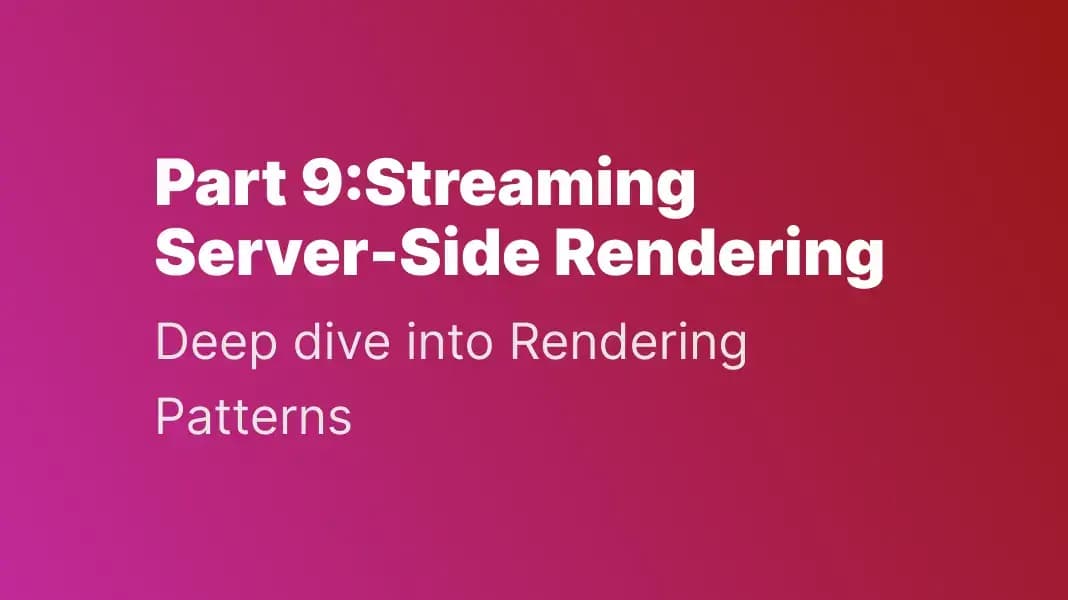user
Hey Chat, could you explain Streaming Server-Side Rendering in simple terms, assuming I have no idea about rendering patterns? 🤔

Hamza Miloud amar
June 29, 2024
5 min read

In our last post, we covered Progressive Hydration. Today, we'll focus on Streaming Server-Side Rendering, an innovative approach that streams HTML content from the server to the client as it is being rendered. This technique reduces time-to-first-byte and improves perceived performance by allowing users to see content faster.
Web Development Group
Me , Server , Browser, CDN, Narrator
user
Hey Chat, could you explain Streaming Server-Side Rendering in simple terms, assuming I have no idea about rendering patterns? 🤔
narrator
Imagine you're at a fancy restaurant and you order a multi-course meal. Instead of waiting for the entire meal to be prepared, the chef sends out each dish as soon as it's ready, starting with the quickest to prepare and ending with the dish that takes the longest. This way, you start enjoying your meal faster without waiting for everything to be finished.
narrator
With streaming server-side rendering, you don't have to wait for an entire webpage to load before seeing it. Instead, the server sends parts of the page as soon as they are ready. This allows you to start viewing and interacting with the initial content while the rest is still being processed and delivered. Think of it like enjoying an appetizer while the chef prepares the main course.
user
Mmm, that sounds interesting! Could you explain a real world example, showing the step by step process of how the server and browser work together to make this happen? 🤔
server
When you request a webpage, my job is to render it as HTML. However, instead of making you wait for the entire page to load, I send you sections of the page as they are ready, prioritizing the fastest elements first. This allows you to start viewing content on your screen sooner than if you had to wait for the entire page to be fully generated.
browser
As I receive each chunk, I add it to the page and immediately hydrate it to make it interactive. So You can start exploring the content before the entire page has finished loading, resulting in a much smoother and faster browsing experience!
user
Wow, that sounds like it would make websites load much faster! 🚀
browser
Precisely! Since users see content earlier, the perceived load time is significantly reduced. Plus, streaming allows for better handling of slow network connections on large pages.
user
I see. What are the main benefits of using Streaming SSR? 🌟
server
performance improvement: Streaming delivers page incrementally. This significantly improves perceived performance, especially for larger or more complex pages, by reducing Time to First Byte (TTFB) and allowing for faster First Paint (FP) and First Contentful Paint (FCP).
server
Selective Hydration: Each part of the page is made interactive (hydrated) as soon as it arrives from the server, providing a seamless and responsive user experience.
server
SEO friendly: Search engines love static websites because of their simple structure and fast loading times. 🏆
user
What are the potential challenges or considerations with Streaming SSR? 🤔
server
Complexity: Identifying and addressing potential performance bottlenecks section and use it as a separate chunk that need to be streamed to don't slow down the page.
server
Caching: Managing cache invalidation can be tricky, as you need to ensure users always get the latest content.
server
Data Consistency: Ensuring consistent data across different parts of the app can be challenging, especially with asynchronous data fetching.
user
Interesting! Are there any frameworks that support Streaming SSR? 🛠️
server
Yes, several frameworks support Streaming SSR. Some popular ones include:
server
Next.js: Offers built-in support for both SSR and Streaming SSR.
server
Hydrogen: A framework by Shopify that leverages Streaming SSR for e-commerce sites.
server
React: With React 18, features like Suspense for data fetching enhance Streaming SSR capabilities. 🌐
user
Thanks, Chat! This was really helpful. Any final thoughts? 😊
server
You're welcome! Streaming SSR is a powerful technique for building fast, efficient web applications. By streaming content as it becomes available, you can significantly improve user experience and performance. If you're interested, next time we can dive into practical implementation examples. Stay tuned! 📚
user
Looking forward to it! 📖
me
Thanks for taking the time to read my article! I'd love to hear your feedback – any questions, suggestions, or different perspectives are welcome. Your input helps me improve and create even better content. Feel free to follow me and continue the conversation on 𝕏 to continue the discussion.
Thank you for exploring Streaming Server-Side Rendering with us. In our next post, we'll discuss Island Architecture, a unique rendering pattern that enhances the performance of interactive applications by isolating dynamic components. Goodbye for now, and see you in our next discussion on Island Architecture!
Experienced Frontend Developer | Passionate about building elegant, accessible, and UX-friendly Design Systems with React | Skilled in React Next Remix | CSS enthusiast | Lover of Clean & Maintainable CSS | Always learning and growing.
Let's ConnectConnect With Me On Social Media
I appreciate your visit to my website. If you find my work interesting and would like to know more about me, please consider following me on social media. Thank you!
© 2026 Hamza Miloud Amar. All Rights Reserved
1488 Views